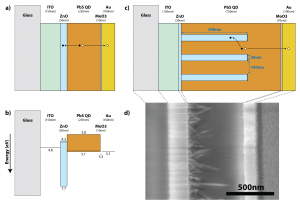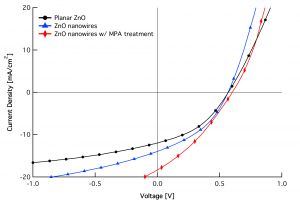Solution-Processed Nanowire-based Quantum Dot Photovoltaics
- Category: Electronic Devices, Energy, Materials, Nanotechnology
- Tags: joel jean, patrick brown, silvija gradecak, vladimir bulovic
Thin-film solar cells incorporating colloidal quantum dot active layers have recently emerged as a notable third-generation photovoltaic (PV) technology, largely due to the strong absorption, tunable infrared bandgap, and ambient-atmosphere stability of lead sulfide quantum dots (PbS QDs). Photoactive PbS QDs can be solution-deposited on a transparent zinc oxide (ZnO) film to form a depleted np-heterojunction device (Figure 1a,b). However, this standard planar architecture incurs a fundamental trade-off between light absorption and carrier collection: to absorb most incident light, we need a ~1-µm-thick QD film [1] , but to collect most photocarriers, we need absorption to occur within a minority carrier diffusion length (~100 nm) of the ~150-nm-thick depletion region [2] . By introducing 1-D nanostructures (Figure 1c), we can decouple these parallel requirements and optimize for each independently. A vertical, QD-infiltrated array of ZnO nanowires orthogonalizes the mechanistic length scales of absorption and collection. Absorption is maximized as light traverses a thick QD film in the axial direction, while field-driven carrier collection is retained throughout the film as photogenerated electrons drift to nearby PbS/ZnO interfaces in the radial direction.
Our research demonstrates that moving from a planar ZnO film to a nanowire array can significantly improve QDPV performance, increasing short-circuit current density (JSC) by ~40% and overall power conversion efficiency by ~15% [3] . We confirm the near-complete infiltration of PbS QDs into the ZnO nanowire array via cross-sectional scanning electron microscopy (Figure 1d) and elemental mapping with energy-dispersive x-ray spectroscopy. We further demonstrate a fast solution treatment to assist interfacial charge transfer using a bifunctional linker molecule, 3-mercaptopropionic acid (MPA). A simple MPA treatment increases both JSC and open-circuit voltage (VOC) of nanowire-QD devices (see Figure 2). Our work on ZnO nanowire-based QD solar cells—along with the recent demonstration of a 5.6%-efficient TiO2nanopillar-based QDPV [4] —suggests that 1-D nanostructures may be the key to enhancing the efficiency and hence the economic viability of quantum dot photovoltaics.
- Figure 1: (a) Schematic and (b) energy band diagram of a standard planar quantum dot photovoltaic (QDPV) device with parallel light absorption and carrier collection pathways. A modified architecture incorporating ZnO nanowires—shown here by (c) schematic and (d) cross-sectional scanning electron micrograph—decouples absorption from collection and extends the effective depletion width throughout a QD film of arbitrary thickness.
- Figure 2: J-V characteristics (under AM1.5G illumination) of planar (black circles) and nanowire QDPV devices fabricated in a single run. Incorporation of ZnO nanowires (blue triangles) boosts the short-circuit current density (JSC) without affecting the open-circuit voltage (VOC). An additional interface treatment with 3-mercaptopropionic acid (MPA) (red diamonds) concurrently increases JSC, VOC, and overall power conversion efficiency of the nanowire-based devices.
- A. G. Pattantyus-Abraham,I. J. Kramer, A. R. Barkhouse,X. Wang, G.Konstantatos, R. Debnath,L. Levina,I. Raabe,M. K. Nazeeruddin, M.Grätzel, and E. H. Sargent, “Depleted-heterojunction colloidal quantum dot solar cells,” ACS Nano, vol. 4, no. 6, pp. 3374-3380, May 2010. [↩]
- K. W. Johnston, A. G. Pattantyus-Abraham, J. P. Clifford, S. H. Myrskog, S. Hoogland, S. Sjoerd, H. Shukla, E. J. D. Klem, L. Levina, and E. H. Sargent, “Efficient Schottky-quantum-dot photovoltaics: The roles of depletion, drift, and diffusion,” Applied Physics Letters, vol. 92, no. 12, pp. 122111, Mar. 2008. [↩]
- P. R. Brown, R. R. Lunt, N. Zhao, T. P. Osedach,D. D. Wanger, L.-Y.Chang, M. G.Bawendi, and V. Bulović, “Improved current extraction from ZnO/PbS quantum dot heterojunction photovoltaics using a MoO3 interfacial layer,” Nano Letters, vol. 11, no. 7, pp. 2955-2961, June 2011. [↩]
- I. J. Kramer, D. Zhitomirsky, J. D. Bass, P. M. Rice, T. Topuria, L. Krupp, S. M. Thon, A. H. Ip, R. Debnath, H.-C. Kim, and E. H. Sargent, “Ordered nanopillar structured electrodes for depleted bulk heterojunction colloidal quantum dot solar cells,” Advanced Materials, vol. 24, no. 17, pp. 2315-2319, Mar. 2012. [↩]

